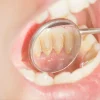Get information about Adult Orthodontics with the explanation of specialist dentist Merve Özkan Akagündüz.
Orthodontics for Adults

Orthodontics for Adults, Doredent İstanbul
The orthodontic treatments applied to adult individuals who did not have the opportunity to undergo orthodontic treatment during childhood or who wish to undergo treatment due to misalignments that have increased with age or other issues are referred to as adult orthodontics.
Orthodontic treatments can be applied to individuals of any age who have healthy teeth and surrounding tissues. Our goal is to create proper dental relationships and a beautiful smile with well-aligned teeth for every individual. In adults, situations where neighboring teeth tilt due to long-lost tooth gaps, making prosthetic or implant applications impossible, increase the need for orthodontic treatment. In such cases, orthodontic treatments can be a necessity rather than a preference.
Adult orthodontics may be sought for correcting misaligned or spaced teeth, jaw disorders, upper and lower teeth closure problems, correcting improperly angled teeth, adjusting or closing gaps left by missing teeth, or improving traumatic occlusion.
Orthodontic treatments often yield faster results in younger ages due to the greater adaptability of teeth and tissues. As age increases, the inorganic matter content of the dental surrounding bone tissue increases, making tooth movements more difficult. However, advances in technology have introduced a wide range of applications in orthodontics to address the disadvantages adults face, allowing for all tooth movements to occur in adult individuals.
When deciding on the treatment method in adult orthodontics, factors such as the patient’s age, the type and severity of the orthodontic problem, the condition of the teeth and surrounding tissues, and the patient’s needs and expectations are taken into account. The orthodontic treatment plan is prepared specifically for each patient based on clinical and radiological examinations. Therefore, each orthodontic treatment varies, and it is not correct to make comparisons between individuals.
In adult orthodontics, various tools such as metal or porcelain braces, ceramic braces, lingual braces, or clear aligners can be used. Orthodontic treatment tools like braces and aligners solve dental orthodontic problems. If there is a skeletal problem such as lower or upper jaw retrusion or protrusion, or combinations thereof, and correction is desired, orthognathic surgical procedures need to be included in the orthodontic treatment plan.
The duration of treatment in adult orthodontics varies depending on the severity of the problem, the treatment method applied, whether surgical procedures are performed or not, and patient cooperation, but it is typically completed within 1 to 2 years.
Orthognathic Surgery
Orthognathic surgery refers to jaw operations performed to correct skeletal problems by repositioning the jaw bones to their proper locations in cases where the lower and/or upper jaw is excessively forward, backward, or sideways relative to the cranial base in adult patients.
The orthognathic surgery procedure can be applied to a single jaw, both jaws, or the chin as needed in individuals who have completed their growth and development. The aim is to contribute to soft tissue and facial aesthetics by repositioning the jaw bones. The planning of the surgery is done in collaboration with orthodontists and maxillofacial or plastic surgeons.
An individual who thinks they have a jaw problem should first consult an orthodontist. After clinical and radiological examination, the patient’s complaints, a list of existing problems, solutions, and the patient’s expectations are thoroughly evaluated. If it is decided that orthognathic surgery is necessary after these evaluations, the process starts with correcting the positions of the teeth. This can be achieved through braces or clear aligner treatments.
Orthodontic treatments before orthognathic surgery typically last about 1 year, although this varies from person to person. Once the teeth are positioned as desired, radiological examinations are repeated, and models are taken from the patient to perform model surgery. Splints to be used during the operation are produced through model surgery, allowing the planned movements to be accurately carried out.
The orthognathic surgery operation is performed under general anesthesia. After the operation, the jaws are bound together with elastics for about 1 week to 10 days, during which the patient is fed with liquid foods. The use of elastics continues for a few more weeks outside of meal times. Post-operative swelling is normal and decreases over time, improving patient comfort.
Orthodontic treatment continues for a while after the orthognathic surgery. Although this duration varies, it is typically around 6-8 months. After this long and tiring process, the patient can be relieved of their jaw and orthodontic problems.
Individuals with skeletal malformations in the lower and/or upper jaw who ideally should undergo orthognathic surgery but do not wish to have surgery are not obliged to undergo the operation. The orthodontist informs these individuals in detail about the situation. All pros and cons are shared with the patient. If the individual is aware of the situation and only wants their teeth to be properly aligned, orthodontic treatment can be applied after obtaining the patient’s consent on the matter.
Merve Özkan Akagündüz
I was born in Edirne in 1988. In 2007, I began my master’s degree in Dentistry at Istanbul University (Çapa) Faculty of Dentistry and graduated in 2012.
In 2014, I started my specialization in the Department of Orthodontics at Süleyman Demirel University Faculty of Dentistry. In 2019, I earned the title of Orthodontist and was appointed to Çorlu ADSM, where I worked as an Orthodontic Specialist Dentist from 2019 to 2022.
As of 2024, I have been continuing my practice in my own clinic.








